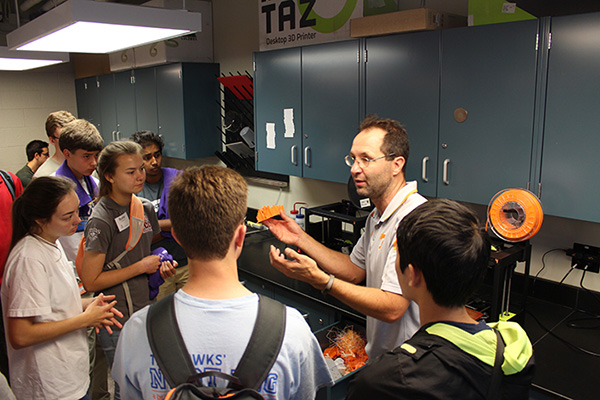
Campus activity heats up along with the temperature each June thanks to a pair of opportunities for high school students.
Materials Science Camp gives a select group of students insight into the department and its disciplines, while Tennessee’s Governor’s School for Engineering has been led by the department for the last five years.
While serving distinctly different purposes, both have increased exposure to potential students for the department, college, and even the university in general.
“Both of these serve as wonderful opportunities for students to learn about what is possible through materials science and in engineering,” said Department Head Veerle Keppens.
Not Just “Whodunit,” But How
Camps come in all shapes and sizes, and just about all of them introduce campers to a new topic.
It’s how the Materials Science Camp goes about doing it that sets it apart from most experiences.
“We realized early on that the amount of fun that campers had would determine how much they retained from their time with us,” said Claudia Rawn, associate professor in the department and director of the Center for Materials Processing.
“The concept we came up with was to turn the camp into a sort of ‘CSI’ scenario, where the kids had to learn different techniques to solve the crime.”
This year’s camp expanded the lesson to include safety.
The case centered around “Professor Knucklehead” and his lax standards in dealing with both equipment and colleagues. A series of errors in judgment led to the start of the chase for campers, but the end of the professor.
“As with anyone not showing respect to students, colleagues, ethical practices, and safety, he met his demise,” said Rawn. “Next to him, students found a note that said ‘the eagle sees at 10,000x’ and a quarter as the only clues.”
Building off that sparse information, campers used devices and machines to string together a series of clues, including:
- Microscopes specializing in imaging features at different length scales
- Using cold rolling to modify brass samples
- Testing mechanical properties of materials through characterization techniques
- Determining compounds and elements through X-ray powder diffraction and energy-dispersive X-ray Spectroscopy
Those techniques and machines allowed the 15 campers to string together the clues, helping them determine which suspect committed the crime and how.
Although the case served as the main focus that tied things together, students were involved in many other aspects of materials science, as well as other fields within engineering.
For example, those interested in biomedical and biomaterials fields got a chance to visit the synthetic cadaver, named MABEline, in the Department of Mechanical, Aerospace, and Biomedical Engineering, while a field trip to ORNL provided a closer look at nuclear engineering and neutron science.
Additionally, Lecturer Chris Wetteland, who ran the camp along with Rawn, demonstrated how solar power could be put to fun use with a sun-powered smoothie station.
“We want them to learn, but we also want them to go back to their communities and say ‘I had fun,'” said Wetteland.
More than 100 students have now participated in the camps since they began in 2006, with many later continuing their connection with the department as undergraduates.
Hello, Guv’nah
Then-Governor Lamar Alexander started the Governor’s School program in Tennessee in 1984 as a way to encourage top students from around the state to pursue and achieve academic excellence.
While the schools for engineering and arts and science were combined in 2007—both are hosted at UT—the focus on top-notch engineering hasn’t changed.
This year, 28 students from all corners of Tennessee converged for the four-week course that introduced them not only to engineering, but also to campus life.
One of the key ways of doing that is by having the high school students spend time with current UT students, a personal touch that doesn’t go unnoticed.
“The students that come here for the month all talk about how neat it was to talk to our students about college, about classes, about any number of things that might concern them as they really start to look at where they might want to attend,” said Wetteland, who also runs this program.
“We like to break the overall group up into smaller sections, which helps increase the amount of attention students receive and results in a better experience for them.”
Each day follows a set routine, with basic coursework in how STEM fields affect society and perfecting STEM skills taking place in the morning, followed by afternoon sessions in particular areas of study.
The benefit of dividing the day in such a way is that all students, regardless of whether you are here for the engineering camp or the arts and science camp, get exposed to some level activity from the other school.
The engineering classes, led by Wetteland and Rawn, had a focus on materials science, particularly the key role it plays in engineering. After all, whether it’s a nuclear reactor, a bridge, a computer, or a chemical battery, you still have to start with the right material.
“Materials science, as a concept, can be hard for young students to grasp, but if you can get across that engineering is all about ‘things’ and that all of those things rely on materials, the importance of what we do is obvious,” said Rawn.
In addition to the in-class study, students also get a primer on what college life can be like by living in residence halls, dining in student cafeterias, and taking part in social events.